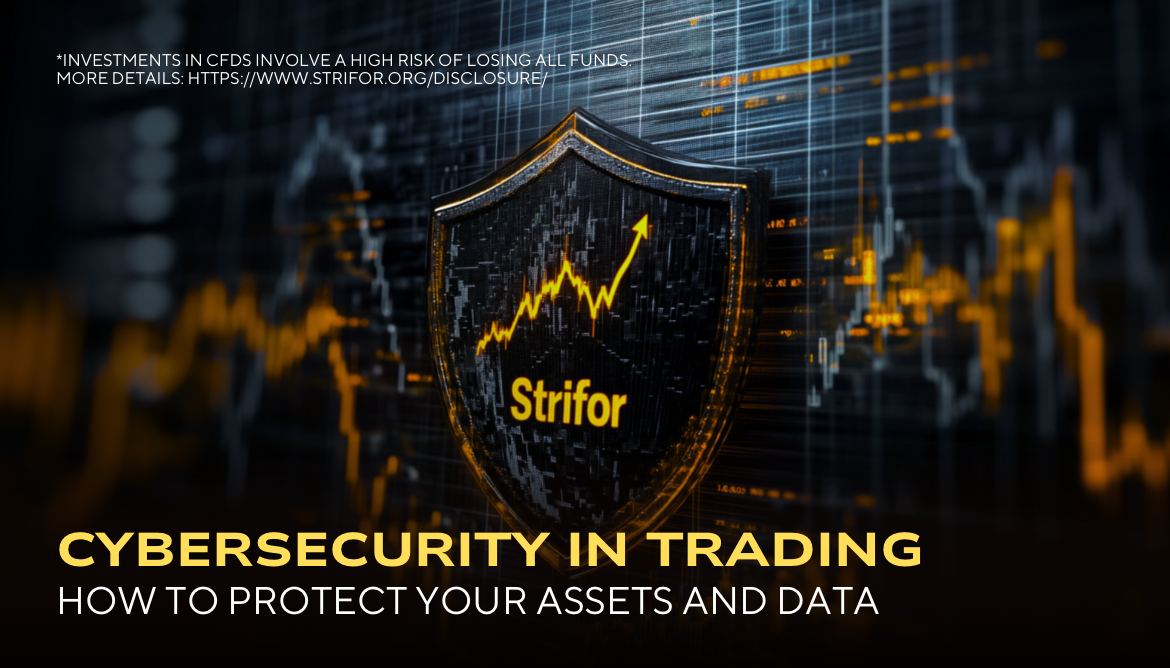
CYBER SECURITY IN TRADING – how to protect your assets and data
Trading, which involves managing large sums of money and using online platforms, inevitably faces cybersecurity threats. Hackers, scammers and malware pose risks to traders, threatening both financial and personal data. In today’s Strifor review, we’ll look at the key aspects of cybersecurity in trading, the threats and how to protect yourself.
Why is cybersecurity important in trading?
Modern trading platforms operate over the internet, making them vulnerable to cyberattacks. Stolen credentials can lead to loss of account access, unauthorized transactions, or leakage of sensitive information. This is especially true for:
- Cryptocurrency exchanges, where lost assets are nearly impossible to recover.
- Forex brokers working with high liquidity.
- Equity and derivatives trading platforms.
Major cyber threats in trading
- Phishing
Fraudsters create fake websites, emails or messages to trick out logins and passwords. For example, a trader may receive an email purporting to be from a broker asking them to “confirm their data,” resulting in a loss of access.
- Malware
Programs that can infiltrate a computer or smartphone to steal data or block access to a system. This is especially dangerous if a trader uses trading automation software.
3- Attacks on exchanges and brokers
Major stock exchanges have already experienced hacking attacks, resulting in massive losses for users.
- Wi-Fi sniffing
Using unsecured public Wi-Fi networks leaves traders vulnerable to data interception.
- Social engineering
Hackers trick traders by pretending to be customer service representatives to gain access to accounts.
How to protect yourself and your assets
- Use two-factor authentication (2FA)
Connect additional security for logging in to the trading platform. For example, in addition to a password, you will need to enter a one-time code from the Google Authenticator application.
- Choose a reliable broker
Before opening an account, check whether the broker uses modern data protection protocols such as SSL/TLS and guarantees the safety of your assets. Strifor pays close attention to user security and regularly updates the platform.
- Do not use public Wi-Fi networks
For trading, it is better to connect through secure networks or use a VPN.
- Update software regularly
This applies to both the operating system and trading applications. Developers regularly release updates to eliminate vulnerabilities.
- Do not click on dubious links
Check website addresses before entering your login and password, especially if you click on links from emails.
- Store cryptocurrencies on cold wallets
Hardware or cold wallets are much safer than hot, internet-connected wallets.
Examples of attacks on trading and their consequences
- Hacker attack on Mt.Gox (2014): The exchange lost 850,000 BTC and thousands of traders were left without assets.
- Bitfinex (2016): Hackers withdrew 120,000 BTC, which was the largest loss at the time.
- Robinhood cyberattack (2021): Leaked personal data of 7 million users, including their financial information.
The role of users in security
Most successful attacks are due to human error. Traders often use simple passwords, click on suspicious links, or ignore updates. A simple shift to a disciplined approach to data handling can protect assets from most threats.
The future of cybersecurity in trading
Advances in technology such as blockchain, machine learning and biometrics promise to increase the security of trading platforms. However, hackers are also improving their techniques. It’s important that traders and platforms continue to develop defense tools.
To summarize
Cybersecurity is not a one-time action, but an ongoing process. Being attentive, using modern technology and following recommendations will help traders keep their assets and confidence in the safety of trading. Remember: protected data is the key to successful trading.
Cyber threats are real and growing. Protect your assets and data by following these simple guidelines and minimize your risk of loss due to cyberattacks. It’s important to us that you trade safely ❤️
Attention! An investment in CFDs carries the high risk of losing all investments funds. 87% of retail investor accounts lose money when trading CFDs with this provider. Past investment success does not mean future success.

 Personal area
Personal area





